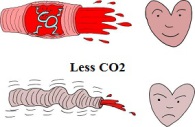Vasodilation – vasoconstriction
During dilation, the blood vessels dilate and the bold flow increases owing to a decrease in vascular resistance.

Among all the arterial dilators, CO2, the natural dilating agent, is the most powerful substance.
Healthy people experience the vasodilation effect due to normal arterial CO2 concentration in their body.
The other potent vasodilator is nitric oxide; this is generated within the human body from the foods that you eat.
In simple terms, arteries and arterioles in our body have their own smooth and tiny muscles that can dilate or constrict depending on the concentrations of CO2. When we breathe more, the level of CO2 in our arteries is reduced; this results in the constriction of blood vessels and vital organs such as heart, kidney, brain, stomach, spleen, liver, colon, etc. experience less supply of blood. Much similar to this, hypocapnia would cause spasms to all the smooth muscles in our colon, bile ducts, diaphragm, air tract, etc. This effect explains as to why sick people have a lesser amount of blood going to their vital organs. A normal breathing phenomenon enables us with a normal perfusion and a favorable oxygen supply to all our vital organs because of CO2 vasodilation.
However, people nowadays hyperventilate (breathe more than the medical norm); hence, they suffer from the effects of CO2-deficiency. Nitric oxide is produced in our sinuses. When we breathe through our mouth, we avoid inhalation of this gas and thus decrease its levels in our body. Deficiency of nitric oxide in our body is one of the factors that promote vasoconstriction.
The state of these arteries and arterioles offer total resistance to the systemic flow of blood in our body. Therefore, hypocapnia puts more stress on our heart. Presence of normal CO2 concentrations in blood vessels decrease the resistance for blood flow (vasodilation); from this we can infer that breathing directly participates in the regulation of heart rate. Professor Yandell Henderson of the Yale University (1873-1944), has investigated this effect about a century ago.
In case you get a small wound and the blood begins to flow out. Observe that when you breathe more (hyperventilate), the flow of blood is decreased. This effect is due to vasoconstriction.
On the other hand, do the opposite; just hold your breath for a while and breathe as less as possible. Now you can see that the blood flow has increased, this must be due to vasodilation. Now you must know what to do after you have a dental surgery or some accidents that involve bleeding.
However, there is no need to breathe heavily on purpose (as over 97% of people do these days). Hyperventilation is a natural phenomenon in humans and all the animals facing such conditions. Hence, hyperventilation can be a lifesaving act in cases of severe bleeding.


